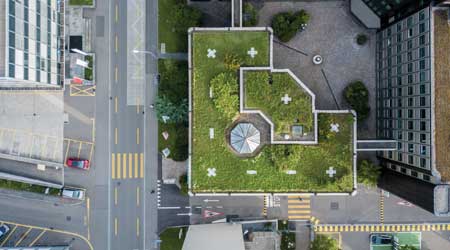Beyond Waterproofing: How to Ensure Long-Term Roof Life
From vegetation to cell phone towers to solar panels, roofs are now being asked to perform many tasks beyond just keeping the elements out. Here's how to ensure a successful roof life with a non-traditional roof.
One evolution in roof design mentioned by both representatives of the roofing materials manufacturers are the challenges to the roof system from using the roof in ways besides waterproofing. As Miranda puts it, “We are expecting roofing systems to do more than they can. We want them to be more than a roof.” As available land shrinks, any real estate in the building is seen as a money loser if it cannot be utilized for something. So now roofs are being used as recreational surfaces, platforms for holding solar panels and integrated PV systems, planting and garden areas, plaza decks, and cell phone towers.
Each of these uses creates its own challenges to the design of the roof and adds new complexity to the system as a whole. In the case of garden roofs (also known as green or vegetated roofs) a whole new set of issues arise. The membranes must be protected from the plant root systems’ ability to penetrate membranes in their search for water. The weight of the plants, planting medium, any water in the system, and any hardscaping for walkways must be accounted for in the design of the structural system. Access to the membrane for maintenance and repair needs to be considered. Irrigation of the plants and access to the plants for maintenance and replacement also must be considered. Access to public areas must be provided for people with disabilities. All these factors require expertise in landscaping, mechanical systems and structural engineering to design such a roof system. Except for the plant-related issues, plaza deck design requires the same considerations as the vegetated roofs.
Recreational surfaces need to have an appropriate surface to cover the membrane so that the sport or play can be accomplished in the designated area. Issues with water getting trapped between the play surface and the roof membrane need to be addressed. Sports using balls or other airborne objects need to have nets or other restraints to keep the public below from harm. The supports for these items need to be addressed in the roof design to assure the watertightness of the penetrations.
Photovoltaic panel systems need racks to raise them off the roof surface to avoid damage to the roof from the heat generated by the PV. The rack system must be engineered for wind resistance and overturning and the roof, and flashing system must be designed to be resistant to repair traffic on the roof.
Cell phone towers add another issue. They generally have small penthouses that are attached to the roof structure but they may not. The roof designer has to investigate the cell phone tower penthouses for waterproofing issues on the structural stands and worse on stairs to the penthouses. Issues with conduit penetrations also need to be evaluated for flashing designs.
Manufacturers are providing total system solutions for tested, compatible materials, making system design easier. However, the use of experienced consulting architects and engineers with specific roofing knowledge can assure that the various components of the roof, the connections of the roof to the walls, the complexities of the roof as platform and the code compliance issues are all addressed in the final design.
Related Topics:















